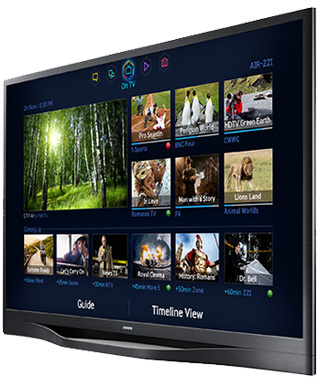Samsung PN51F8500 Review: A 51-Inch Plasma HDTV With SmartHub
Only two companies still make plasma TVs, so we’re excited to check out Samsung’s latest, the PN51F8500. It boasts 3D, SmartHub 2.0, and superb image quality. In the vast ocean of LCD televisions, it’s a compelling choice. Our lab results show you why.
Samsung PN51F8500 51-Inch Plasma HDTV Review

I remember seeing my first flat-screen TV in a Circuit City many years ago. It was a 32-inch plasma panel, and it was selling for $5000. Back then, LCDs were just starting to appear on desktops, but the technology wasn't yet available in large enough screen sizes for the living room. If you wanted a television you could mount on the wall, plasma was it.
As you already know, the tables turned completely. LCDs can be found in sizes up to 80 inches, while prices have dropped tremendously. Where every manufacturer once offered multiple plasma models, now only LG and Samsung continue to market them.
Our latest HDTV review subject is the PN51F8500. Samsung sent us the 51-inch model to look at, but you can also get it in 60- and 64-inch formats. They all have the same features and differ only in price: $1800, $2400, and $3100, respectively.
| MSRP | $1800 |
|---|---|
| Panel Type | Plasma |
| Screen Size | 50.7-inch |
| Max Resolution | 1920x1080 |
| Max Refresh Rate | 96 Hz |
| Aspect Ratio | 16:9 |
| Speakers | 2 x 10 W |
| HDMI 1.4a | 4 |
| Component Video | 1 |
| RF/Antenna | 1 |
| Audio Out | 1 optical |
| Control | IR in, RS-232 |
| USB | 3 |
| Ethernet (RJ-45) | 1 |
| Panel DimensionsWxHxD w/base | 46.9 x 29.4 x 10.6 in1182 x 741 x 267 mm |
| Panel Thickness | 2 in / 50 mm |
| Bezel Width | 1-1.5 in / 25-38 mm |
| Weight | 51.6 lbs / 23.4 kg |
| Warranty | One year |
If you visit any A/V forum, you will undoubtedly find threads devoted to debating LCD versus plasma technology. Obviously, LCD won decisively in the marketplace. If plasma penetrated the living room first, how did this turn of fate occur?
For those who have not previously considered a plasma HDTV, let me offer a little primer about how it differs from LCD. Firstly, the only thing the two technologies share in common is that they’re flat panels. After that, the similarity ends.
LCD is a light valve display, which means that light is filtered and polarized by the pixel structure to produce the red, green, and blue primary colors. Plasma, on the other hand, uses pixels that are self-illuminating. The red, green, and blue sub-pixels are like tiny light bulbs. They’re filled with a gas, which, when stimulated by current, cause a phosphor deposit on the inside of the cell to glow. The cell’s brightness is then controlled by varying the voltage.
The principal advantage of this approach is greater contrast. You can’t turn a plasma pixel off completely like a CRT phosphor. But at the minimum voltage, it’s much darker than an LCD pixel. Superior black levels translate to a greater dynamic range. If you agree with us that contrast is the most important component in image quality, then you might consider plasma for your next HDTV purchase.
Stay On the Cutting Edge: Get the Tom's Hardware Newsletter
Get Tom's Hardware's best news and in-depth reviews, straight to your inbox.
The main disadvantage is power consumption. A large LCD panel with an LED backlight might draw 100 watts at peak load. Plasmas can draw as much as 500 watts displaying bright content. And an LCD will give you more light output at a given current level. If you have a room with incoming sunlight, a plasma might not muster enough brightness for your application.
Before we move on, I should explain a spec you may have seen in Samsung’s (and other manufacturers') marketing: 600 Hz sub-field drive. Since plasma, like CRT, is not a sample-and-hold technology, there is a dark period between each frame as it is flashed on the screen. This is the reason for plasma’s superior motion processing and lack of blur. The actual amount of time each frame appears is only one or two milliseconds. So, to maintain brightness and prevent flicker, the image is refreshed multiple times per frame. If the sub-field rate is 600 Hz, it means that each frame is refreshed 10 times. Ten refreshes x 60 Hz = 600 Hz.
Current page: Samsung PN51F8500 51-Inch Plasma HDTV Review
Next Page Packaging, Physical Layout and Accessories
Christian Eberle is a Contributing Editor for Tom's Hardware US. He's a veteran reviewer of A/V equipment, specializing in monitors. Christian began his obsession with tech when he built his first PC in 1991, a 286 running DOS 3.0 at a blazing 12MHz. In 2006, he undertook training from the Imaging Science Foundation in video calibration and testing and thus started a passion for precise imaging that persists to this day. He is also a professional musician with a degree from the New England Conservatory as a classical bassoonist which he used to good effect as a performer with the West Point Army Band from 1987 to 2013. He enjoys watching movies and listening to high-end audio in his custom-built home theater and can be seen riding trails near his home on a race-ready ICE VTX recumbent trike. Christian enjoys the endless summer in Florida where he lives with his wife and Chihuahua and plays with orchestras around the state.
-
Nuckles_56 People still buy plasma screened TV's? I thought they went out like the floppy disk...Reply -
Merry_Blind Damn Samsung TVs have so much lag... They have amazing picture quality, but aren't fast enough for proper gaming... sigh... bring on the OLED!!!Reply -
n3cw4rr10r Am I the only one who thinks this is overpriced? especially with 4k TVs getting close to this range (Vizio P series will be out soon for $1000).Reply -
n3cw4rr10r Am I the only one who thinks this is overpriced? especially with 4k TVs getting close to this range (Vizio P series will be out soon for $1000).Reply -
colson79 It is such a shame everyone bailed on Plasma TV's, I still have one and the picture quality blows away LCD in the home theater. Hopefully my Plasma will last until OLED is reasonable. It would suck having to go to LCD.Reply -
jkhoward I love the quality of Plasma TV's.. I truly hope they keep developing this technology.Reply -
DisplayJunkie @Nuckles_56 your level of ignorance is astronomical yet not uncommon; you are making a fool of yourself.Reply
@n3cw4rr10r It's not overpriced at all, but rather an outstanding value (though not as good a value as the sorely-missed Panasonic P50ST60). The image quality is tremendously better than any 4K TV, even with perfect 4K source content, even if they sold the 4K TVs for $1500 or less. The difference in contrast(dynamic range) is the most important, and it is huge. Side-by-side with the plasma, no one would pick any 4K LCD. -
nthreem It's worth noting that Samsung announced it will discontinue production of plasmas at the end of the year. Better pick one up soon!Reply
I got a Panasonic VT60 at the beginning of the year, just as stock was running dry. I'm still amazed by the picture quality. -
Nintendo Maniac 64 ReplyHopefully my Plasma will last until OLED is reasonable.
Actually OLED is arguably already there or getting there. Some people were able to pick up LG's 55" OLED TV for $2000 (not a typo) via in-store at Microcenter.
For a more universal price-point, it's newest revision is now going for $3500. -
photonboy ReplyDamn Samsung TVs have so much lag... They have amazing picture quality, but aren't fast enough for proper gaming... sigh... bring on the OLED!!!
Most HDTV's have a "GAMING MODE" option which disables video processing inside the HDTV for a particular HDMI input such as your game console might use.
Having said that, burn-in issues have never been completely solved so I wouldn't game on a Plasma anyway (seems an important thing to mention doesn't it?).